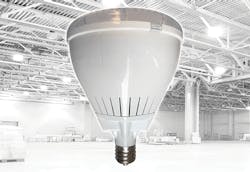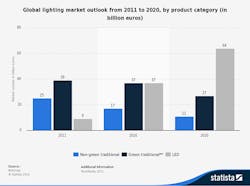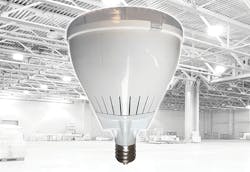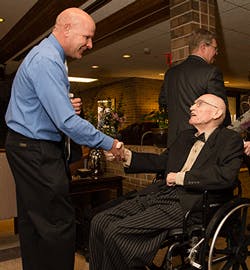A New Spark of Innovation in the Age of LEDs
In the early 1980s, the lighting industry was ripe for disruption—but no one knew it yet.
Back then, industrial lighting and fluorescents relied on electromagnetic ballasts for power—a transformer technology that is, by today's standards, decidedly inefficient and ill-equipped for indoor industrial use.
At the time, though, this system represented state-of-the-art technology. There were no other competing technologies in the field, and no sign that any other solution was on its way up.
Until an inventor named Peter Shen turned the lighting world on its head. Shen developed and brought to market the first electronic ballast—a far more efficient alternative to the magnetic standard.
"In just a few years, the whole world converted," recalls John Einarsen, CEO of OEO Energy Solutions.
Businesses, he says, began swapping out their fixtures as fast as possible and manufacturers scrambled to update their product lineups.
It was a classic story of innovation. The industry was suffering from inefficiencies it didn't know it had, and it took an outside piece of innovation brought to market ex nihilo to expose those inefficiencies.
The industry was overhauled almost overnight—flourishing businesses fell, new leaders emerged, smart businesses shifted with the times.
But that was more than 30 years ago.
As these metal halide lights hum along, churning out thousands of watts worth of light with a decades-old standard of efficiency, newer, better technology is standing by to disrupt the industry once again.
An Old Tale, Revisited
"The same story that played out back in the 80s is happening again now with LEDs," Einarsen says. "LED technology, by its very nature, is folding the industry over."
The reason for this takeover is pretty clear: LEDs are more efficient, they last longer, and they produce better light. Just like the electronic ballast did in its time, LEDs are making the technology of old irrelevant.
For example: A 380 Watt “plug-n-play” LED from OEO replaces a 1,000 Watt metal halide bulb without requiring any fixture replacements or upgrades, making the new technology 62% more efficient. Bulbs like these also increase the life expectancy from about 13,000 hours to more than 50,000 hours—that's about 5.7 years compared to 18 months.
However, to date, the adoption of this new technology has been tempered by two roadblocks.
Cost of Revolution
The first issue, of course, is cost. LEDs are expensive. They are far, far more expensive than the metal halide lights—as much as 10 times more expensive when it comes to the big, industrial options. But that’s only on the front end.
"Operating 1 Watt of energy 24 hours a day, seven days a week at the current national average cost per kilowatt hour—about $0.136—comes to about $1.20 per Watt, per year," Einarsen explains. "That is roughly $1,200 per year to operate one 1,000-Watt bulb."
Einarsen estimates that there is at least one 1,000-Watt bulb per every thousand square feet of factory environment. In that case, a typical 100,000-square-foot facility would spend roughly $120,000/year just to light the building.
LEDs, on the other hand, bring that per-bulb cost down to about $456/year, or about $45,600 for that same 100,000-square-foot facility.
That translates to an immediate savings of $74,400/year in energy costs and significant additional savings in maintenance costs for the HID systems.
OEO's 380W “plug-n-play” LED bulb directly replaces 1,000 W metal halide bulbs without the need for new fixtures or wiring. The change represents a 62% drop in energy usage alone, which can add up to $732 in annual savings, per bulb plus HID maintenance cost savings.
But where the new technology really becomes cost prohibitive is in installation.
"Converting a plant over to LED fixtures is difficult and expensive," Einarsen says. "A full fixture upgrade can take weeks; it relies on union laborers to install, and it requires machines to be shut down and lines to stop.
"It can become really expensive, really quickly."
The costs involved in full upgrades can completely offset the potential savings the technology offers.
Or, at least that's how it used to be.
"There's a shift going on that not everyone recognizes," Einarsen explains. "People are stuck in this idea of full fixture replacements, but that's because they don't know new technology is out there that makes them irrelevant."
This new technology, he says, is the innovation the industry has been waiting for. It's the move that will finally make the LED revolution flicker into life.
Direct Replacement: A Revolution in the Making
Direct replacement LEDs – an invention from OEO’s LED technology engineer, Dr. Leo – pack in all of the low-heat, high-efficiency functionality of LEDs and plug them directly into legacy lighting fixtures. In the process, they bring installation time for an entire plant from weeks to days with no work stoppage, no downtime, and no exaggerated maintenance costs.
In other words, it is a game changer.
"This is proving to be enormous," Einarsen says. "It's going to fold the industry all over again."
So far, only a small handful of companies have caught onto this new capability, and they have quietly begun making a stir in the industry. The revolution, it seems, is coming.
OEO President, John Einarsen, meets with the inventor of LED lighting, Dr. Nick Holonyak, to discuss the state of the industry and the explosive years of growth ahead for direct-replacement LED technology for HID lamps.
OEO, which so far manufactures the only 1,000-hour direct replacement bulb, offers all of the same stats as full fixture alternatives—50,000 hours of operation, 62% energy savings, etc., for a bulb that costs less than $400.
But, beyond that, it has also set a precedent that Einarsen expects to be absolutely infectious in the industry. Even more infectious than the electronic ballast.
This precedent was recently recognized in Navigant Research’s Q1 2016 Report: Industrial and High Bay Lighting, in which OEO was recognized as a “Key Industry Player” in plug-n-play LED technology. See: https://www.navigantresearch.com/research/industrial-and-high-bay-lighting
Finally, the roadblocks that have kept LEDs from disrupting the status quo have been removed.
"There is no longer any reason to hold off on LEDs," he explains. "The problem has been solved.”
The true cost now, he says, is in doing nothing.
About the Author
Travis Hessman
VP of Content, Endeavor Business Media
Travis Hessman is the VP of Content for Endeavor Business Media. Previously, Travis was the Editor-in-Chief for Industry Week and New Equipment Digest as well as the Group Editorial Director for Endeavor's Manufacturing Group.
He began his career as an intern at IndustryWeek in 2001 and later served as IW's technology and innovation editor. Today, he combines his experience as an educator, a writer, and a journalist to help address some of the most significant challenges in the manufacturing industry, with a particular focus on leadership, training, and the technologies of smart manufacturing.




